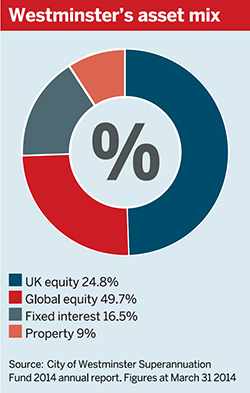The City of Westminster Superannuation Fund has decreased its UK equity holdings in favour of global stocks to give managers greater flexibility and boost performance.
More schemes are turning away from UK equities in favour of global investments in order to gain greater outperformance.

The £996m scheme increased its allocation to global equities to 49.7 per cent at March 31 this year, up from 37.5 per cent at the same time in 2013, according to its draft 2014 report and accounts.
Its allocation to UK equities dropped to 24.8 per cent from 36.4 per cent over the same period.
Jonathan Hunt, director of corporate finance and investment at the scheme, said one of the reasons for investing in UK equities was the link between domestic economic events and the performance of the companies listed.
“The liabilities of the pension fund are linked to inflation and other UK-related events,” said Hunt.
He said more funds with a UK bias are looking to expand overseas.
“The original reason for being in UK-listed stocks only begins to fall away,” he said.
Investing more in global equities will give managers more flexibility to outperform, he added.
Nicola Ralston, director of PiRho Investment Consulting, said there has been a growing trend towards defined benefit schemes reducing their allocation to UK-only equity mandates.
“Typically if you believe an active manager is skilled, why would you not want them to compare European pharmaceuticals with Japanese and American pharmaceuticals and let them decide where they want to fix their money?,” said Ralston, adding that this would give them more flexibility to add value.
Mark Nicoll, partner at consultancy LCP, agreed that investing more in global equities gives managers more of a chance to outperform. “The UK is a very narrow market – it’s relatively concentrated,” said Nicoll.
Tackling low gilt yields
The Westminster fund also reduced its allocation to fixed income assets to 16.5 per cent from 21.6 per cent in 2013, according to the report.
This is largely due to a reduction in gilt holdings, which Hunt said was a short-term move while the scheme decides what fixed income assets to invest in to bring the allocation back up to around its 2013 level.
Giltsyields have remained low this year, and Ralston said most schemes have already reduced their allocation to the asset class. “It’s more of a question of when they will increase that exposure,” she added.
Nicoll said most schemes are very closely monitoring the amount of exposure they have to bond-like assets. An alternative to this could be to use a liability-driven investment strategy, he said.
“Rather than investing in bonds through physical assets, [schemes could] maybe replace that with an LDI portfolio that is leveraged,” he added.
For example, if a scheme was three-times leveraged, for every £90m it hedges it would need to hold only £30m and could invest the other £60m elsewhere, he said.
Other assets a scheme could invest in could include absolute return bonds, which have a cash base rather than being linked to interest rates, said Nicoll. “Particularly as corporate bond yields have come down quite a lot,” he said.
The scheme also doubled its allocation to property to 9 per cent in 2014 from 4.5 per cent the previous year. This was part of a long-term strategy to steadily increase the scheme’s allocation to property.














